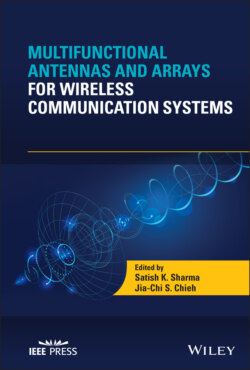Читать книгу Multifunctional Antennas and Arrays for Wireless Communication Systems - Группа авторов - Страница 18
1.5 Multifunctional Antennas
ОглавлениеMultifunctional antennas can have features of frequency reconfiguration, polarization reconfiguration, beam steering, flexible radiation patterns, and radiation pattern reconfiguration in a single antenna structure. Combination of a couple of these features makes these antennas “multifunctional.” These antennas can meet multiple wireless communication standards and hence can provide multiple communication applications. Such antennas can also be multiband in nature and can have multiple‐input‐multiple‐output (MIMO) implementations. Also, multiple communication antennas on a common small size host platform, such as cellular phone size ground plane, can be categorized as “multifunctional” antenna.
Figure 1.3 Antenna performance shown using (a) reflection coefficient magnitude (S11, dB) and (b) 3D gain radiation pattern.
The full‐polarization reconfigurable antenna can switch between the vertical and horizontal linear polarizations, right‐hand circular polarization (RHCP), and left‐hand circular polarization (LHCP) depending on the communication system requirements. These antennas offer advantages of reduced antenna hardware, low weight, and low cost. Such antennas are very attractive to emerging wireless communications such as 5G communication systems. One such antenna is shown in Figure 1.4, which offers both frequency tunability and polarization reconfiguration [2].
Figure 1.4 (a) Top view photograph of a frequency tunable concentric circular microstrip patch antenna along with varactor diode placement locations, (b) photograph of the fabricated control feed network, (c) measured frequency tunable response for both feed ports, and (d–g) comparison between the measured and simulated gain radiation patterns for 4 V bias voltage which corresponds to 1.36 GHz tunable band for horizontal linear, vertical linear, RHCP, and LHCP, respectively.
Source: Babakhani and Sharma [2].
Tunable antennas, mostly, frequency tunable can be designed by incorporating variable capacitors in a radiating element in suitable placement arrangements. Figure 1.4a shows photograph of a prototype frequency tunable concentric circular patch antenna where four varactors (Skyworks SMV 1234) are placed between the central patch and the outer ring patch. Two feed ports are selected so that both linear and circular polarizations can be obtained by suitably exciting feed points. Figure 1.4b shows photograph of the control feed network which provides polarization reconfiguration along with simultaneously frequency tunability. The control feed network uses single pole double through (SPDT) and single pole 4 through (SP4T) RF switches along with quadrature power divider, dual in package (DIP) switch, and control lines for biasing varactor diodes and RF switches. A DIP switch is included to apply DC voltage to control the state of the switches. To bias the varactors for tunability, the central patch is connected to the positive pole through the feed network circuit. For the radiation pattern measurements in the anechoic chamber, varactor diodes were biased with a Jameco Electronics DC–DC Boost Converter.
The frequency response with bias voltage variation is shown in Figure 1.4c. With 0 V bias, the antenna resonates at the lowest frequency (1.17 GHz). Similarly, with 12 V bias, the antenna operates at 1.58 GHz. Thus, this antenna provides frequency tunability between 1.17 and 1.58 GHz which corresponds to 30% tunability. By applying bias voltage to two varactors each along with one feed point, vertical and horizontal linear polarizations are achieved. Similarly, applying the same bias voltage to all the varactors and exciting both feed points in ±90° time phase difference, right hand (RH) or left hand (LH) circular polarization is obtained. Measured and simulated radiation patterns are shown in Figure 1.4d–g for 1.36 GHz (4 V bias) for all four polarization cases. Similar was the pattern response for all other frequency tunable bands but are not shown for the sake of brevity.
